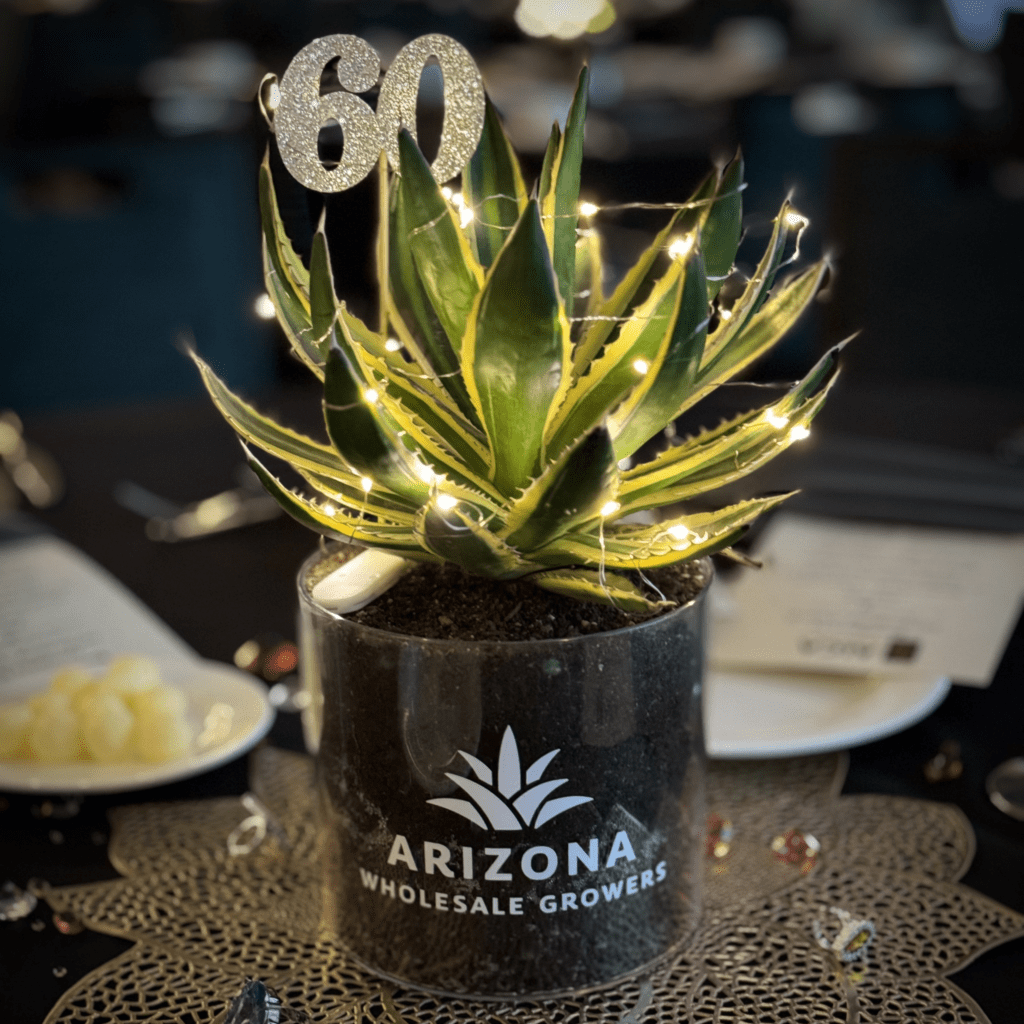Search
Displaying results for: Agave
Agave fernandi-regis (Syn. Agave ferdinand-regis) King Ferdinand Agave

Often mentioned as “the King of Agaves”, these elegant plants form short, round tight rosettes of green and white. The leaves are triangular or more precisely, deltoid in shape, wide at their base, tapering to a short, black terminal spine, but the leaf edges are smooth and white in color. It is these leaf margins that leave the distinctive white, linear crisscrossed bud imprints on leaf surfaces, looking as though a yeoman actually painted each leaf by hand for the king himself. These Agaves are related to the Queen Victoria Agave and many variations exist, but with the onset and technology of tissue cultured clones we can all expect the finest selections will prevail. Despite their noble appearances, these are tough, and durable plants. They perform very well in filtered light but they will tolerate full sun, with some acclimation to hottest western exposures. Provide them with well-drained soils, as with other Agaves.
Agave colorata Mescal Agave, Mescal Ceniza
Evergreen, rosette forming Agave with gun-metal gray, wide spoon-shaped leaves armed with large mammillate marginal teeth. Leaf surfaces have a distinctively rough texture, often with some horizontal banding, but always with an interesting and dramatic tooth impression. They can and will offset some but the pups remain close to the base of the mother plant. These Agaves are particularly well suited to our xeric landscapes since they are native to thorny woodland habitats of Sonora, Mexico. As they mature, the mother plant has the peculiar habit of listing over to one side, perhaps they have evolved to allow the pups to not become over-crowded and allow them more sun. Whatever the reason, this is normal and they do not require staking or propping up as I have often witnessed. These fantastically dramatic Agaves are sadly underutilized in urban landscapes.
Agave x ‘Blue Glow’ 'Blue Glow' Agave
This is a hybrid agave, between two other favorites, Agave attenuata and A. ocahui. Like all hybrids, the offspring display only the best qualities provided by both parents. This is a small, well-behaved Agave with flat to slightly cupped leaves that are silvery-blue green color and have a short reddish terminal spine. They form a nearly symmetrical round shape similar to A. ocahui. The leaf margins possess no teeth, they are thin, golden red in color with a spectacular translucence that allows the plant to literally glow when it is back-lit in the late afternoon or morning sun. Plant these beauties in masses, to accent hardscape elements, as individual specimens or in modern minimalistic containers, but site them where the sun will allow them to glow.
Agave x ‘Blue Flame’ 'Blue Flame' Agave
This Agave has soft, unarmed blue green leaves with a flame-like appearance from which its common name was derived. It is a luscious looking clump forming or groundcover type hybrid Agave. Individual plants grow at a moderate rate to 2-3 ft. high & wide, but as they age, they will continue to multiply to form groups that can spread 4-8 ft. in width. They are great for use at poolside, water features and patios where you want to maintain a soft, invitingly cool, tropical appeal. Minimal maintenance, but they prefer regular supplemental water through the first summer or two. As with other Agaves, well-drained soil is a must.
A Glowing Evening at the 2023 ALCA Gala
Congratulations to all the winners and ALCA for an outstanding 60th-anniversary awards gala last Saturday. We were happy to contribute with 50 glowing agave centerpieces!
November 18th, 2023
Melampodium leucanthum Blackfoot Daisy
Bright white cheerful daisy flowers on a durable subshrub. These woody to herbaceous perennials form short ground-hugging mounds of narrow rough olive green foliage and bloom consistently from fall to early summer in low deserts. Flowers are classic white daisy petals around a yellow disc. Plants appreciate regular irrigation for a season until established, but become drought tolerant after. Light trimming or shearing can help to tidy them up post blooming. Little maintenance otherwise. They tolerate high heat, but they will grow as understory groundcovers to desert trees and large shrubs. Too much shade prevents best flowering though. They are most dramatic when planted en masse, but individual plants also pair well with other desert perennials, palms, and bold accent plants like Agaves, cacti, and arborescent yuccas.
Sphaeralcea ambigua Globe Mallow, Desert Mallow
Gray-green floriferous perennial shrubs. Triangular gray-green pubescent foliage grows on vertical stems from basal woody clumps. Wild native plants are summer deciduous, in urban landscapes plants are evergreen, but can be shorter lived. In spring to summer bright orange 1 in. mallow blooms occur on 2/3 of every stem making a bright and striking flower display. They require water to get established but can eventually exist on rainfall alone but will go dormant during the heat of low desert summers unless they are provided periodic water. Globe mallow shows up in mixed grasslands, rocky slopes, washes, and roadsides in association with virtually every other type of native plant. They work well as flowering accent plants with ocotillos, cacti, yuccas and Agave sp. Since they establish and grow fast, planting them periodically year to year will ensure some will always be there blooming if some do peter out.
Anisacanthus quadrifidus v. wrightii Flame Honeysuckle, Flame Acanthus
Blooming hummingbird delights! Orange tubular to red colored flowers appear in summer and last until fall. Adaptable, drought tolerant once established. Plants are fast growing with bright green leaves on woody upright stems. These heat loving plants offer more lush appearance than other SW native shrubs. They can grow 4 to 5 ft. high and wide, but are easily kept shorter if needed. They will adapt to mesic or desert landscapes equally well. They blend well with Yucca species, Agaves, misc. cacti and other native accent plants like ocotillos. Or pair them with other gray leafed shrubs, groundcovers or with mixed desert perennials.
Dasylirion wheeleri Desert Spoon
Handsome round-forming tough accent plants. These true southwestern native succulent-looking, evergreen silvery gray accent plants are more common and more adaptable than many Agave sp. They are tolerant of heat and cold, occurring naturally from about 2500 ft. up to 6000 ft. They are also tolerant to and accept more frequent waterings, especially when young and during the hottest months of summer. They are equally effective in mass plantings as they are when used as solitary specimens. Plants can thrive for years in large containers too. Like other Dasylirions, they will eventually produce tall stalks with fluffy flowers from the top to about 1/3 of the way down. Large specimens can form multiple heads that can produce multiple stalks.



